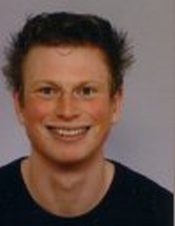Energy barriers in patterned media
Promotion date: October 17.
Promotor: Prof.dr. Miko Elwenspoek
Assistant promotor: Prof.dr.ir. Leon Abelmann
| Within the Ataktos project the origins of the variation in switching field for individual magnetic islands in magnetic patterned media are investigated. Patterned magnetic media are one of the possible replacements for the polycrystalline media present in current hard disks. Using a patterned magnetic medium a high bit density can be achieved while maintaining the stability of the written data. One of the current obstacles is the large variation in switching field for the individual islands. Within the Ataktos project - which is Greek for naughty or order less - the possible causes for the variation in switching field for individual islands are investigated. The islands are created in Co/Pt multilayers using Laser Interference Lithography (LIL). The switching field distribution of the patterned media is investigated using, among others, an Anomalous Hall Effect setup (AHE) which is sensitive enough to measure the switching of individual islands. |
What was special in your approach during the PhD research?
For the next generation of data storage, magnetic patterned media seem attractive. However, there is a variation in required switching field from one island to the next. Furthermore there is a distribution in required switching field for a single island.
We used Laser Interference Lithography to fabricate these ‘magnetic islands’ and used the sensitive Anomalous Hall Effect setup to determine the energy barrier, which prevents spontaneous magnetic reversal of these islands, by measuring this distribution for single islands. The determined energy barrier is not a constant for all of the islands, and depends on the temperature at which the distribution is measured. This result will have implications for the way in which energy barriers are determined because the measurement temperature is very important.
The start of the PhD period was quite application oriented, centered around fabricating these magnetic patterned areas. As the project progressed more fundamental issues were addressed, which were in fact even more exciting to investigate. Here,a more scientific way of research was required.
Can you mention some special moments that occurred during the PhD project?
There were several moments worthwhile mentioning indeed. In the course of the project we were able to experiment under cryogenic conditions, performing measurements at only ten degrees Kelvin. Here, I was able to corroborate an important part of my theory and knowledge of the field. Although the average switching fields were higher, the distribution of the switching fields around the median was smaller, proving the distribution was thermally induced.
A second moment I recall, was the interest shown for our research at various conferences on magnetism. It showed the valuable approach of our group, Transducers Science and Technology, was of importance in the field of magnetism and our special approach was appreciated by these experts.
Even more impressive in my view, were the measurements I performed at Forschungszentrum Jülich using specialized Scanning Transmission Electron Microscopy. Here I was able to actually perceive the structures we fabricated, which are only 0.3 nanometers in size. Seeing the ‘magnetic multilayer’ for the first time was a very special moment.
Did you publish some articles on this topic?
The Journal of Applied Physics published one article. Also I was a co-author on several other publications. Three more manuscripts are in preparation. I have good expectations they will be published shortly.
In what way did you develop as a researcher and scientist in these four years?
Of course, I learned a lot of things and my knowledge level is significantly greater. I feel much more confident in gathering knowledge and skills on themes and fields I am not specialized in yet. I got more acquainted to physics and materials science, as I was an electro technical engineer when I started four years ago.
Various aspects merged in my PhD project, which I am very content about. My presentation skills and writing abilities are much more mature now. In fact, I will miss the aspect of presenting during conferences in the near future, I expect.
What are your future plans now?
I am looking for a research job at one of the spin-off companies that started here at the University of Twente. There are several of them, and I have good contacts to some of them already. I am hoping to find all aspects of the work I experienced at Mesa+: fabricating, measuring and analyzing high-tech devices.
I guess, the deadlines will be somewhat stricter in industry, nevertheless I believe the challenges will be as rich as they were during my PhD period.
To stay successful in future, are there important things to consider for Mesa+ as a research institute?
I was involved in daily routines at Mesa+ only in some periods while fabricating the samples in the cleanroom. I collaborated more with groups from universities in Japan and Manchester than here at Mesa+. We had yearly meetings at STW, discussing the progress of research.
Nevertheless, I valued the visiting of famous speakers to the Mesa+ Day as very remember able. It broadens one’s scope and vision of research. I value the facility sharing of equipment at Mesa+ so companies can benefit from these also. I guess, a good balance has to be found for operating time available for researchers and PhD’s in comparison with commercial activities.

